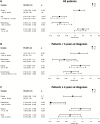Evaluation of age-dependent treatment strategies for children and young adults with pineoblastoma: analysis of pooled European Society for Paediatric Oncology (SIOP-E) and US Head Start data
- PMID: 28011926
- PMCID: PMC5464312
- DOI: 10.1093/neuonc/now234
Evaluation of age-dependent treatment strategies for children and young adults with pineoblastoma: analysis of pooled European Society for Paediatric Oncology (SIOP-E) and US Head Start data
Abstract
Background: Pineoblastoma is a rare pineal region brain tumor. Treatment strategies have reflected those for other malignant embryonal brain tumors.
Patients and methods: Original prospective treatment and outcome data from international trial groups were pooled. Cox regression models were developed considering treatment elements as time-dependent covariates.
Results: Data on 135 patients with pineoblastoma aged 0.01-20.7 (median 4.9) years were analyzed. Median observation time was 7.3 years. Favorable prognostic factors were age ≥4 years (hazard ratio [HR] for progression-free survival [PFS] 0.270, P < .001) and administration of radiotherapy (HR for PFS 0.282, P < .001). Metastatic disease (HR for PFS 2.015, P = .006), but not postoperative residual tumor, was associated with unfavorable prognosis. In 57 patients <4 years old, 5-year PFS/overall survival (OS) were 11 ± 4%/12 ± 4%. Two patients survived after chemotherapy only, while 3 of 16 treated with craniospinal irradiation (CSI) with boost, and 3 of 5 treated with high-dose chemotherapy (HDCT) and local radiotherapy survived. In 78 patients aged ≥4 years, PFS/OS were 72 ± 7%/73 ± 7% for patients without metastases, and 50 ± 10%/55 ± 10% with metastases. Seventy-three patients received radiotherapy (48 conventionally fractionated CSI, median dose 35.0 [18.0-45.0] Gy, 19 hyperfractionated CSI, 6 local radiotherapy), with (n = 68) or without (n = 6) chemotherapy. The treatment sequence had no impact; application of HDCT had weak impact on survival in older patients.
Conclusion: Survival is poor in young children treated without radiotherapy. In these patients, combination of HDCT and local radiotherapy may warrant further evaluation in the absence of more specific or targeted treatments. CSI combined with chemotherapy is effective for older non-metastatic patients.
Keywords: high-dose chemotherapy; pediatric; pineoblastoma; radiotherapy; treatment.
© The Author(s) 2016. Published by Oxford University Press on behalf of the Society for Neuro-Oncology. All rights reserved. For permissions, please e-mail: journals.permissions@oup.com
Figures



References
-
- Louis DN, Ohgaki H, Wiestler OD, et al. WHO Classification of Tumours of the Central Nervous System.4th ed Lyon: International Agency for Research on Cancer; 2007.
-
- Gerber NU, von Hoff K, Resch A, et al. Treatment of children with central nervous system primitive neuroectodermal tumors/pinealoblastomas in the prospective multicentric trial HIT 2000 using hyperfractionated radiation therapy followed by maintenance chemotherapy. Int J Radiat Oncol Biol Phys. 2014;89(4):863–871. - PubMed
-
- Kaatsch P, Spix C. German Childhood Cancer Registry—Report 2013/2014 (1980–2013).Mainz, Germany: Institute of Medical Biostatistircs, Epidemiology and Informatics (IMBEI) at the University Medical Center of the Johannes Gutenberg University Mainz; 2014.
MeSH terms
Substances
LinkOut - more resources
Full Text Sources
Other Literature Sources
Medical

